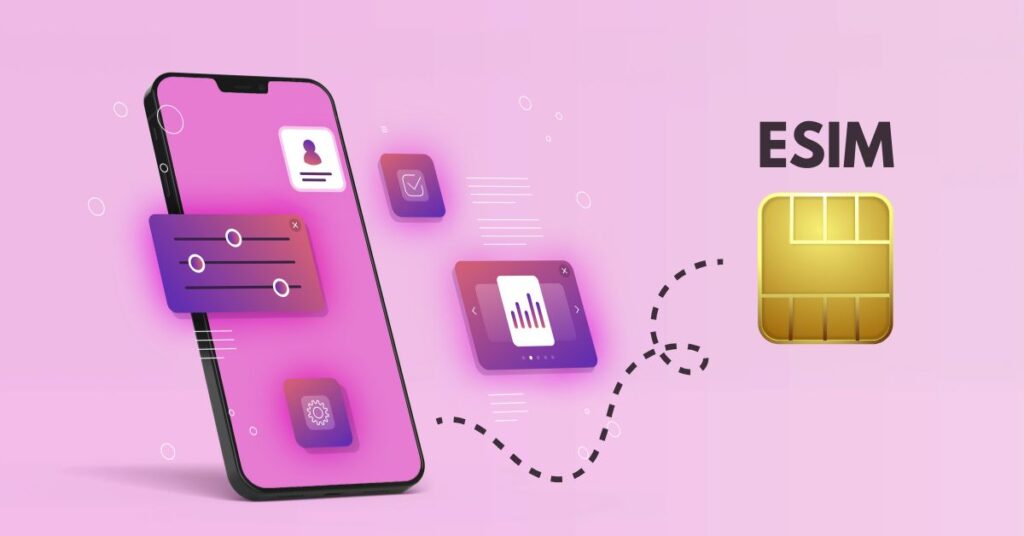The Global System for Mobile Communication (GSMA) developed the eSIM (embedded SIM) technology in 2012. The eSIM became recognized when Apple launched the first eSIM iPhone in September 2022. Now, slowly, eSIMs are entering and conquering industries such as travel because they are more affordable and secure than local SIMs and public Wi-Fi while traveling internationally. As we see, there is lots of confusion surrounding this technology, so we have decided to explain all the frequent questions raised about eSIM.
eSIMs are beneficial for both Consumers and Service Providers (SP) in the telecom industry as it is fully digitalized and affordable services.
What is eSIM? A Complete Guide for Beginners

What is eSIM?
In simple language, an eSIM is a digital, non-removable SIM. Its function is similar to that of a traditional plastic SIM card, but it is physically integrated into the device, i.e., it is built into the device. It can not be removed or replaced with another SIM. The eSIM does not work on its own the user needs to download the operator’s eSIM profile to make it functional. The entire process of activation is online and fully digital.
When did eSIM come into the picture?
eSIM was initially designed for the Internet of Things (IoT) sector in 2010 to make it easy to fit this SIM on IoT devices over physical SIM cards. As eSIM is embedded on the motherboard of devices and can be operated remotely which is not possible with physical SIM in unmanned or inaccessible connected objects. When Apple implemented the similar technology in iPhone it became apparent that the same technology could be used in consumer devices. Due to security reasons, GSMA was reluctant to introduce this technology but in 2016 the use of eSIM in consumer devices was approved.
How does eSIM work?
eSIM works similarly to traditional plastic SIM. The only difference is the activation process. The plastic SIM needs to be inserted into a device, while the eSIM is an inbuilt part and must be activated digitally. After activation of eSIM, it works similarly to physical SIM. The benefit of eSIM is that you can have multiple eSIM profiles on a single device and you can change the profile from phone settings. It eliminates the need to swap physical SIMs.
What is the difference between eSIM and physical SIM?
| e-SIM | Physical SIM | |
| Location | It is inbuild inside, soldered on device motherboard. | It is removable |
Delivery | It is an integral part of the device while | It can be brought in store or delivered via post. |
Operator | 1-20 depend on device model | only one or 2 at a time |
Activation | It can be activated by downloading operator profile online | It is activated by simply inserting it into SIM slot. |
Carbon Footprint | 123g CO2 and SIM | 229g of CO2 |
Travel friendly | Yes | No |
What is an eSIM profile?
The information about the operator is known as an eSIM profile which is required for the identification and authentication of SIM cards with the network. In plastic SIM cards, the operator profile is already pre-programmed directly onto the SIM and it is irremovable. In the eSIM user needs to download the operator profile or eSIM profile onto the chip of the device. Most of the devices can hold multiple eSIM profiles at the same time on a single device and they are interchangeable.
Is eSIM safe?
Yes, eSIMs are safe. The eSIM is embedded on the motherboard of the device so it cannot be removed from the device. Therefore no one can steal the information on eSIM unless the user’s phone is stolen. If the situation arises in case the user’s phone gets stolen it becomes harder to dismantle the phone and extract data from eSIM.
What is eSIM Activation?
It’s a part of the remote SIM provisioning process. The e-SIM gets activated when you download the e-SIM profile from the service provider and install it into your device. E-SIM activation is real-time, which means whenever users want to use the e-SIM they can activate it.
What are the main types of eSIM activation?
There are three main types to activate your eSIM Manual Activation, QR code-based activation, and In-app eSIM activation.
- Manual Activation:- In this user needs to type SM-DP+ (this is a code with connects the user device to the service provider’s server) address through the device settings. This is a most complex and unrecommended option to activate eSIM
- QR Code-based activation:– When users purchase an eSIM mobile data plan from a service provider they will receive one QR code on their registered email or mobile number (Mostly by email). The user needs to scan this QR code to activate the eSIM.
- In-app eSIM activation:– This activation is takes place using service providers self-care mobile app. In this user just needs to TAP on the button inside the app and within 60 sec the eSIM will get activated. This is the most recommended and user-friendly option for activating eSIM.
What are the benefits of eSIM?
- For Consumers:-
- Convenience:– The whole process of using or activating the eSIM is digital, online, and simple. The consumer can buy, download, and activate their eSIM any time they want just in a single app.
- Timesaving:- The user does not need to visit a physical store to purchase a plastic SIM and insert it into the phone. The eSIM activation through the service provider app only takes 60 seconds in just one tap.
- Flexibility:– The user can keep multiple service providers’ eSIM profiles on a single eSIM.So users can swap between different service providers digitally with no need to swap the SIM.
- Security:– As the eSIM is an inbuilt part of the device motherboard, so no one can steal it which makes it difficult to remove from the phone. eSIM makes the stolen device easier to find and harder to sell.
- For Business:-
- Cost Saving:– The traditional plastic SIM come up with manufacturing and logistic costs. The eSIM cost in comparison is 80% lower (No packaging and delivery cost involved). In eSIM only cost involved is the activation fee.
- Improves customer satisfaction:-The eSIM allows the operator to fully digitize the customer onboarding and in turn the entire customer journey. In this digital era, digitization is what customers are expecting from every service provider. The eSIM provides a way for customers to travel hassle-free with network connectivity which is a major part of customer satisfaction.
What is the future of eSIM?
When Apple launched his first ever eSIM iPhone it generated curiosity in mobile manufacturing companies to study and launch this telecom technology in their phone too. This technology is new for many consumers but slowly they are known to it and started utilizing it. The benefits of the eSIM are more attractive than the plastic SIM which provides more flexibility and convenience to the consumers.
In the upcoming year, every mobile is coming with this technology to provide a digitalized experience to its consumers. As his technology is cost-saving for both consumers and Service providers its popularity is increasing day by day as a result many industries are adapting this technology to generate high revenue. Soon this technology will capture the entire market in the telecom sector.


